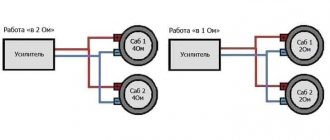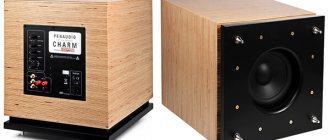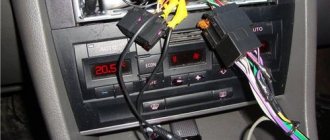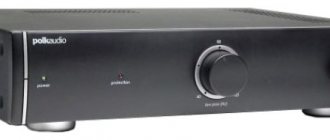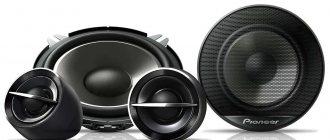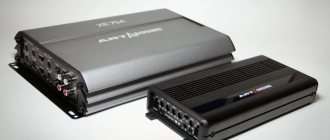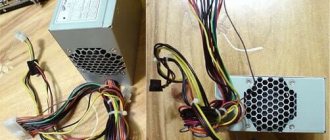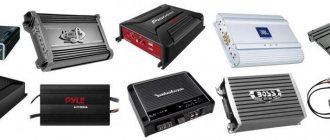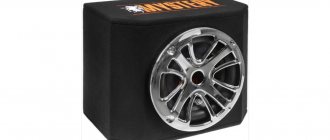If passive speakers are used to output sound from a TV or computer, the system must have a special power amplifier. To carry out the connection procedure, the number of channels does not matter - both stereo and 5.1 or 7.1 systems are connected in completely the same way.
The amplifier is used in passive sound output systems, the speakers of which do not have built-in amplifiers in their design. Without a third-party amplifier, in this case, the sound quality will deteriorate, and due to a mismatch between the speaker impedances and the microcircuit that reproduces sound files, the sound card in the device may burn out.
Standard amplifiers are designed for stereo systems consisting of two speakers or two speakers and a subwoofer. They are connected to the amplifier by connecting it to the speakers using two RCA audio cables. If you need to amplify the sound to play it in 5.1 or 7.1 systems, you will need to combine several amplifiers into a single system or use an AV receiver.
Amplifier or receiver?
A receiver is essentially the same amplifier, only improved. It contains a radio receiver and a device for decoding and distributing multi-channel signals of different standards. For watching movies, the receiver will be the best choice, although you can use a separate decoder and separate amplifiers for each channel. If the speakers will be used to listen to high-quality music, on which attention is concentrated more intensely, higher-quality equipment that creates less distortion may be required. Here the choice is based on financial capabilities and ear sensitivity - a standard system is quite enough. In order for all equipment to have an adequate cost, the price of the receiver should be no more than 100% of the cost of the speakers themselves.
Price
Most experts believe that the price of an element depends on the price of the speaker system and should be 10% of its cost. For example, if the system was purchased for $1000, then the speaker cable should cost at least $100.
When purchasing a cable, you need to start from your own financial resources. If there are not too many of them, you can buy a small cable from a well-known manufacturer. Instructions are provided with the speakers. Sometimes it contains a description of the cables that are suitable for a given system. Such recommendations will save the owner from searching for the required type.
When connecting the speaker cable to the speakers, be sure to measure the length of the wire correctly. It should connect in a straight line and not have any twists. Such defects will affect the quality of the reproduced sound.
Amplifier selection
When choosing a power amplifier, you need to pay attention to a number of important characteristics:
- maximum power;
- operating power;
- distortion factor of the pure signal coming out of the microcircuit of the device that outputs sound to the speakers;
- number of available channels (usually 5.1 or 7.1);
- a set of audio stream formats that can be processed by the device;
- the number of audio inputs and, accordingly, the range of equipment available for connection.
You can, of course, rely on hearing, but in this case the accuracy will not be very high, especially if you do not have enough experience. It is better to consider the following points:
- the amplifier must have a resistance that matches the resistance of the speakers - a discrepancy between the values can lead to a variety of consequences, from a simple deterioration in sound quality to complete system inoperability;
- the power of the amplifier must be at least one third of the maximum power of the available audio equipment;
- The thickness of the wires for connecting the speakers to the amplifier should be at least 1.5 mm2, the more the better.
- Audio equipment can be used for a variety of purposes, including:
- playback of music files of different quality;
- playing files in video format;
- recording, editing and mixing of music tracks.
In the latter case, obviously, the equipment must be of the highest quality so that the amount of distortion in the audio stream is minimized.
Using equipment for other purposes does not necessarily imply complete sound purity. Some distortion when converting sound by the receiver is quite acceptable. Moreover, various types of distortion can decorate or spoil music, depending on its genre. Ideally, of course, distortion should not occur along the path of the amplifier-cable-speakers chain.
Scheme development
The connection diagram depends on the number of amplifier inputs, the location and power of the speakers, and the presence or absence of a subwoofer.
Power amplifiers are:
- two-channel, designed to connect only a pair of speakers;
- four-, used to connect two speakers and a subwoofer or four (there is also a daisy chain connection scheme for four speakers and a subwoofer);
- six-, used for a standard connection of four pieces and a subwoofer.
It is also important to consider the rated power (W, W) and the resistance of all connected equipment (Ohm). They can be found either on device labels or in technical documents
The total connection resistance should not exceed the maximum permissible standard.
There are three ways to connect speakers to an amplifier.
A set of connectors on the receiver body
A full-fledged home theater receiver allows you to connect not only audio output, but also image output. So it has the following interfaces:
- connector for analog stereo sound – tulip, or RCA;
- various connectors for digital audio – S/PDIF, multichannel RCA, HDMI;
- SV >
AV receiver Onkyo TX-NR828
For analog signals, component cables are best suited - tulips, and for digital signals - universal HDMI.
Other types
Other materials are also used for the production of speaker cables, which, in combination with copper, provide high-quality sound.
- Composite cables. They consist not only of copper, but also of other metals. For example, the inside of the cable is made of copper and the top is coated with a metal alloy.
- Combined cables. They intelligently combine metal with non-metal. The most popular is a cable where copper and carbon are mixed. At the same time, the resulting speaker cable has improved technical characteristics.
- A cable made of several types of wires. To find out which types are used, you need to look at the labeling.
How to connect speakers to an amplifier
If you are using a passive sound system with a subwoofer, you will need a two-channel power amplifier. If there are a lot of speakers, you will have to use a four-channel amplifier. You cannot connect both a subwoofer and an amplifier to a two-channel amplifier at the same time, as the power will become too high and the device may burn out.
The speakers are connected to the amplifier with special wires. Usually this is an RCA, or tulip, consisting of two cables - red and white for different channels. They are connected on one side to the speakers, the other to the corresponding connectors on the amplifier body. Then the amplifier is connected by cable to a device that outputs sound - a radio, computer or TV. Remember that you can connect either two front speakers or one subwoofer to a two-channel amplifier, but not all together.
The four-channel power amplifier can connect 4 speakers or 2 speakers and a subwoofer. To connect the speakers to the correct connectors, you need to focus on the labels of the audio inputs - the front connectors are called Front Left and Front Right for the left and right speakers, respectively, and the rear ones are called Rear Left and Rear Right. If you also need to connect a subwoofer, then it should be connected to the connectors for the rear speakers, and in any case, the front speakers are connected to the front connectors.
Adviсe
Let's give some advice.
In addition to calculating the load on the equipment in a specific connection, it is important to correctly select the wires that match the resistance in the circuit. Preference can be given to acoustic wires, which give the purest sound at the output, or to ordinary wires with R not lower than 4 ohms. To avoid damage and short circuit, the polarity of the contacts + to - should be strictly observed. When you turn on the radio for the first time to check, the volume should be minimal
If the sound is distorted, the equipment should be turned off immediately. This effect occurs when the polarity of the connections is not observed, which will have to be corrected.
What you will need
Before starting installation, you need to prepare the following materials:
- insulating tape;
- metal tubes for connecting cords;
- switching parts for connecting to vehicle electrical circuits;
- acoustic and electrical cords with clamps;
- fasteners for brackets.
The list of additional equipment expected to be installed depends on the financial capabilities and preferences of the owner. It is important to remember that the further operation of the acoustics depends on the characteristics of the amplifier. For example, if you connect a sub to a 2-channel amplifier, you will need to cut the playback frequency range for 2 channels. In this case, it is recommended to install a 4-channel unit using the rear outputs to bridge the subwoofer.
Tools
To install the equipment and connect connecting cords, you will need the following tools and materials:
Are you a car driver?! Then you can take this simple test and find out. Go to test »
- side cutters for cutting cables and removing insulation;
- screwdrivers and wrenches for dismantling plastic casings;
- connecting clamps;
- test device for checking the integrity of power circuits;
- additional terminals and tool for installing lugs.
How to choose a wire cross-section
Since the external amplifier consumes current up to 40-50 A (depending on the modification), it is necessary to select a suitable power cable for connection. To calculate the cross-section, you will need to find out the rated power of the equipment, which is indicated in the operating instructions and on the factory label. The total energy consumption is equal to the product of power and the number of channels involved. For example, when a 50 W signal is supplied to 1 loudspeaker, the total consumption for 4 channels will be 200 W.
Then you need to calculate the length of the cord going to the battery. Based on the obtained figures, a multi-core copper cable with the required cross-section is selected from the table. It is recommended to take a wire with a margin of 10-15%, which will allow you to safely connect the amplifier in the car. It is not recommended to use aluminum strands or elements with a copper-plated surface.
To connect acoustic components, interconnect cables supplied with the products are used. To improve sound quality, it is recommended to purchase improved cords equipped with high-quality switching elements. The connecting speaker cables have a standard design, differing only in the quality of the materials used.
Fuse selection
The fuse protects the vehicle's electrical wiring and amplifier from damage due to short circuits or increased current due to overload. The element is installed in the positive connection wire near the battery terminal. The rating of the insert is determined based on tables taking into account the cable length and cross-sectional area. Additional automotive-type fusible links (knife) are located in the housing of the amplifier unit.
Speaker placement
When installing high power rear channels, they must be installed correctly. Oval speakers are mounted on the rear parcel shelf so that the speaker axis is directed diagonally across the vehicle. The rear right column should be aimed at the driver, and the left column at the front passenger. Only after proper installation has been carried out can the speakers be connected to the audio system.
To ensure high-quality sound, the speakers cannot be covered - they need more space to work properly. As for the tweeters, they need to be installed on the windshield pillars. If you mount them away from low-frequency speakers, you can achieve a bright quad effect. The direction of the tweeters is done in a similar way - the front left one is directed towards the passenger, and the right one - towards the driver. The wiring must be secured securely.
Many car owners are not satisfied with the quality of the standard audio system in the car, so they purchase a head unit and components that meet increased requirements. In this case, the question arises of how to connect the speakers to the radio and whether it can be done with your own hands.
How and where to install
The amplification unit is located in the passenger compartment or luggage compartment of the car. The product body is rigidly fixed with brackets; it is not recommended to tilt or turn the module over due to disruption of ventilation and cooling conditions. The location of the equipment under the seat reduces the length of switching lines and improves sound quality (due to reduced losses).
It is possible to install the amplifier in the car under the rear parcel shelf located behind the back of the seats. The device is mounted using brackets; cables for power supply and speaker connections are routed under the plastic trim of the interior. Some machines use 2 amplifier units designed to connect standard speakers and a subwoofer. The units are installed separately - in the passenger compartment and luggage compartment of the car.
Which ones are better to put
The choice of speakers for a car radio should take into account the needs of the car owner. There are several options. The appropriate location of the device will depend on the size and type (for example, it is better to place speakers in the door or on the back shelf).
- Home speakers. Such devices must be connected to the dashboard via a digital input.
- Portable speaker. It is most often connected via Bluetooth.
- Powerful acoustic speakers for cars. For demanding audiophiles, these are the best speakers that provide spacious, clear sound.
How to strengthen
During installation, it is necessary to carefully strengthen the speakers, since the sound quality and duration of operation of the device directly depends on this.
How to setup
The car owner, having installed the unit, configures the operating parameters in accordance with the documentation attached to the product. The methodology and specifics of tuning depend on the technical characteristics of the equipment and the personal perception of the sound picture by the tuner. If the user is not confident in his own abilities, then it is recommended to contact a specialized center that installs and configures car acoustic systems.
To set up an amplifier connected to standard speakers, you will need to follow these steps:
- Select the high pass filter level at 60-80 Hz.
- Set the Gain sensitivity control to the minimum position, and then increase the volume level on the head unit to maximum. Start gradually increasing the Gain level until noise or distortion appears in the broadcast sound.
- Set the volume parameters based on your own perception. Additionally, it is possible to adjust the frequency cutoff value specified by the filter. To improve the sound picture, it is possible to activate the low frequency enhancement mode (bass boost).
If the amplifier circuit is also connected to a subwoofer, then it is necessary to limit the high frequencies using a high-pass filter. When setting, a value within the range of 50-80 Hz is selected. If the car uses a subwoofer with a bass reflex, then a subsonic corrector is used for adjustment. Some amplifiers use an additional phase corrector, which makes it possible to coordinate the operation of the subwoofer with the rest of the speakers.
Speakers (speaker systems) differ in the amount of signal power supplied. There are rated, maximum and peak powers. Peak power is sometimes called maximum short-term power and even the duration of its exposure is specified.
It must be said that the value of speaker power, due to the importance of this parameter for a large group of music lovers, is interpreted differently by marketers. Often, for marketing purposes, the maximum permissible power is significantly overestimated.
As for Soviet speakers, the value of the maximum power supplied to them can be found in the accompanying documentation or here.
The documentation usually indicates two parameters, rated and nameplate power.
Rated power is the input signal power at which the speaker system can operate for a long time without significant distortion.
Nameplate power is the input signal power at which the speaker can supposedly operate for a limited time. In fact, using this parameter for practical purposes is quite problematic when it comes to multi-way speaker systems.
Judge for yourself. For example, you have at your disposal an audio amplifier with a power of 2x100 Watts at a load of 4 Ohms and the once popular 35AC (S90) speakers with a resistance of 4 Ohms with a nameplate power of 90 Watts.
If we connect such an amplifier to a computer and, using an equalizer, direct all the signal power to high-frequency speakers (tweeters), the power of which is only 10 watts with a resistance of 8 ohms, then it turns out that we can direct about 50 watts of power to a dynamic head designed for rated power only 10 watts and the nameplate, say, 20-30 watts. In other words, in this situation, only a miracle can save the “tweeters” from destruction.
Connecting the subwoofer
Most often we have to deal with subwoofers that are part of speaker systems of different configurations - 2.1, 5.1 or 7.1. Connecting such devices, since they are designed to work in conjunction with a computer or DVD player, usually does not cause difficulties. It is enough to determine which connector this or that type of speaker is connected to.
Read more: How to turn on sound on a computer How to connect a home theater to a computer
Difficulties begin when we try to turn on a subwoofer, which is a separate speaker purchased in a store or previously included in another speaker system. Some users are also interested in the question of how to use powerful car subwoofers at home. Below we will discuss all the connection nuances for different types of devices.
There are two types of low-frequency speakers - active and passive.
Option 1: Active woofer
Active subwoofers are a symbiosis of a speaker and auxiliary electronics - an amplifier or receiver, which, as you might guess, is necessary to amplify the signal. Such speakers have two types of connectors - input for receiving a signal from a sound source, in our case, a computer, and output for connecting other speakers. We are interested in the first.
As you can see in the image, these are RCA or “Tulip” type jacks. In order to connect them to a computer, you will need an adapter from RCA to miniJack 3.5 mm (AUX) of the “male-male” type.
One end of the adapter is connected to the “tulips” on the subwoofer, and the other to the connector for the low-frequency speaker on the PC sound card.
Everything goes smoothly if the card has the necessary port, but what happens when its configuration does not allow the use of any “extra” speakers other than stereo?
In this case, subway exits come to the rescue.
Here we also need an RCA – miniJack 3.5 mm adapter, but of a slightly different type. In the first case it was “male-male”, and in the second case it was “male-female”.
There is no need to worry that the output on the computer is not specifically designed for low frequencies - the electronic filling of the active subwoofer will “separate” the sound itself and the sound will be correct.
The advantages of such systems are compactness and the absence of unnecessary wire connections, since all components are placed in one housing. The disadvantages follow from the advantages: this arrangement does not allow you to get a fairly powerful device. If the manufacturer wants to have higher performance, then the cost increases along with them.
Option 2: Passive woofer
Passive subwoofers are not equipped with any additional units and for normal operation they require an intermediate device - an amplifier or receiver.
The assembly of such a system is carried out using the appropriate cables and, if required, adapters, according to the “computer - amplifier - subwoofer” scheme. If your auxiliary device has enough output jacks, you can also connect a speaker system to it.
The advantage of passive low-frequency speakers is that they can be made quite powerful. Disadvantages - the need to purchase an amplifier and the presence of additional wire connections.
Option 3: Car subwoofer
Car subwoofers, for the most part, are characterized by high power, which requires an additional 12 volt power source. A regular power supply from a computer is perfect for this.
Please ensure that its output power matches the power of the amplifier, external or built-in. If the power supply turns out to be “weaker,” then the equipment will not use all its capabilities. Due to the fact that such systems are not intended for home use, their design has some features that require a non-standard approach
Below is an option for connecting a passive subwoofer with an amplifier. For an active device, the manipulations will be similar
Due to the fact that such systems are not intended for home use, their design has some features that require a non-standard approach. Below is an option for connecting a passive subwoofer with an amplifier. For an active device, the manipulations will be similar.
Conclusion
The subwoofer will allow you to get more pleasure from listening to your favorite music. Connecting it to a computer, as you can see, is not at all difficult; you just need to arm yourself with the necessary adapters, and, of course, the knowledge that you received in this article.
Describe what didn't work for you. Our specialists will try to answer as quickly as possible.
Multi-way speaker systems.
Speaker systems differ in the number of frequency bands into which the amplifier's output signal is divided.
In single-way speaker systems, the entire output of the amplifier is sent to one or more identical speakers.
In two and three-way speakers, the amplifier signal is separated using passive filters that are located inside the speaker housing. Such systems use dynamic heads designed to reproduce a certain audio frequency band.
Speakers are divided into four groups: high-frequency, mid-frequency, low-frequency and full-range. By their name you can guess what frequency range they reproduce.
There are also multi-band speaker systems that do not contain bandpass filters. Such systems require a signal already divided into bands corresponding to the sound heads. In such cases, multi-band amplifiers or external filters (crossovers) are usually used.
Wiring issue
When installing wiring, there are several important rules to consider.
- If there are no specialized holes in the doors for pulling wires through, you will have to drill them yourself.
- The wire should not pass through metal and plastic without protection. For safety reasons, it is recommended to use spacer rings. They are fixed on the inside and prevent contact of the wiring with the casing.
- The cable to the head unit should be laid under the interior trim. The best option is to secure the cable from the speakers to the main wiring using electrical tape.
Wire marking
Most speaker systems are equipped with a set of cables that have colored insulation. Thus, FR (front right speaker) is marked in gray, FL (front left speaker) is marked in white. The wires for the rear speakers are similarly different. For the right rear (RR) use purple insulation, for the left (RL) - green. The cable on “-” has the same insulation color as on “+”, but is supplemented with a black stripe.
If the wires for connecting the speakers have all the insulation in the same color, the cable must be marked. This will allow you to connect the speakers to the radio in your car quickly and correctly.
Why is it better to choose copper cable?
Speaker cables are made from copper, copper with tin or silver, and also from metal with non-metallic additives (for example, carbon). The best choice is pure copper wire. Copper can be monocrystalline or oxygen-free, highly purified. The second variety is the best because it does not contain impurities that would increase the resistance.
Pure copper wire
The sound quality directly depends on how much distortion the conductor introduces. Therefore, the key characteristic of a material is its resistance. The lower the cable resistance, the better the signal. Impedance is affected not only by the material, but also by the diameter and length of the cord, but if the material has high impedance, other characteristics will not improve the sound quality.
Copper has low resistance. Even if the cable cross-section is small, the acoustics sound cleaner with a copper conductor than with a large-diameter cord made of a different material. The usual diameter of copper conductors is 2-4 square meters. mm. With a cord length of 3 m and a diameter of 2.5 sq. mm the resistance will be zero. Keep in mind that the longer and thinner the speaker wires, the greater the resistance, and this affects the sound quality.


